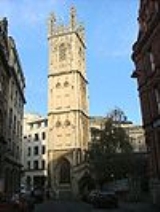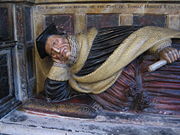
St Stephen's Church, Bristol
Encyclopedia
St Stephen's Church in St Stephens Avenue, is the parish church for the city of Bristol
, England
.
It has been designated by English Heritage
as a grade I listed building.
, which was diverted at around this time to create Bristol Harbour
. The clerestory
was repaired after a storm in 1703. The aisle
and east windows were restored
in 1873.
The tower measures approximately 18 ft by 20 ft at its base, and rises to a total height of 152 ft. It originally contained six bells but these have been replaced over the years and the number increased to twelve. The tower is typical of Somerset
churches, but with the addition of a "Gloucestershire
crown" of arcaded battlements, pinnacle
s and open-work arcading.
The 15th-century brass
eagle
lectern
and the iron
sword rest by William Edney of about 1710 were moved to St Stephen's from St Nicholas
church, which was damaged in the Bristol Blitz
.
merchant, has a tomb
on the north side of the church.
Another significant tomb is that of Martin Pring
, who died at the age of 46 in 1627. He was a navigator, explorer and merchant and discovered what is now called Cape Cod Bay
. The monument is draped with painted mermaid
s and mermen
and verses to his exploits.
 Sir Walter Tyddesley, who died in 1385, and Sir George Snygge also have ornate tombs in the church.
Sir Walter Tyddesley, who died in 1385, and Sir George Snygge also have ornate tombs in the church.
Also commemorated, but this time in a wall-mounted plaque, is Robert Kitchin, who died in 1594, a donor of one of the famous "nails" found outside The Exchange
in Bristol.
Bristol
Bristol is a city, unitary authority area and ceremonial county in South West England, with an estimated population of 433,100 for the unitary authority in 2009, and a surrounding Larger Urban Zone with an estimated 1,070,000 residents in 2007...
, England
England
England is a country that is part of the United Kingdom. It shares land borders with Scotland to the north and Wales to the west; the Irish Sea is to the north west, the Celtic Sea to the south west, with the North Sea to the east and the English Channel to the south separating it from continental...
.
It has been designated by English Heritage
English Heritage
English Heritage . is an executive non-departmental public body of the British Government sponsored by the Department for Culture, Media and Sport...
as a grade I listed building.
History
It was built, on the site of an 11th century church, in the 14th century and rebuilt around 1470. The tower and east window were paid for by John Shipward, four times Mayor of Bristol, who died in 1473, the tower being built by the mason Benedict (or Benet) Crosse. The site was on the banks of the River FromeRiver Frome, Bristol
The River Frome is a river, approximately long, which rises in Dodington Park, South Gloucestershire, and flows in a south westerly direction through Bristol, joining the former course of the river Avon in Bristol's Floating Harbour. The mean flow at Frenchay is The name Frome is shared with...
, which was diverted at around this time to create Bristol Harbour
Bristol Harbour
Bristol Harbour is the harbour in the city of Bristol, England. The harbour covers an area of . It has existed since the 13th century but was developed into its current form in the early 19th century by installing lock gates on a tidal stretch of the River Avon in the centre of the city and...
. The clerestory
Clerestory
Clerestory is an architectural term that historically denoted an upper level of a Roman basilica or of the nave of a Romanesque or Gothic church, the walls of which rise above the rooflines of the lower aisles and are pierced with windows. In modern usage, clerestory refers to any high windows...
was repaired after a storm in 1703. The aisle
Aisle
An aisle is, in general, a space for walking with rows of seats on both sides or with rows of seats on one side and a wall on the other...
and east windows were restored
Victorian restoration
Victorian restoration is the term commonly used to refer to the widespread and extensive refurbishment and rebuilding of Church of England churches and cathedrals that took place in England and Wales during the 19th-century reign of Queen Victoria...
in 1873.
The tower measures approximately 18 ft by 20 ft at its base, and rises to a total height of 152 ft. It originally contained six bells but these have been replaced over the years and the number increased to twelve. The tower is typical of Somerset
Somerset
The ceremonial and non-metropolitan county of Somerset in South West England borders Bristol and Gloucestershire to the north, Wiltshire to the east, Dorset to the south-east, and Devon to the south-west. It is partly bounded to the north and west by the Bristol Channel and the estuary of the...
churches, but with the addition of a "Gloucestershire
Gloucestershire
Gloucestershire is a county in South West England. The county comprises part of the Cotswold Hills, part of the flat fertile valley of the River Severn, and the entire Forest of Dean....
crown" of arcaded battlements, pinnacle
Pinnacle
A pinnacle is an architectural ornament originally forming the cap or crown of a buttress or small turret, but afterwards used on parapets at the corners of towers and in many other situations. The pinnacle looks like a small spire...
s and open-work arcading.
The 15th-century brass
Brass
Brass is an alloy of copper and zinc; the proportions of zinc and copper can be varied to create a range of brasses with varying properties.In comparison, bronze is principally an alloy of copper and tin...
eagle
Eagle
Eagles are members of the bird family Accipitridae, and belong to several genera which are not necessarily closely related to each other. Most of the more than 60 species occur in Eurasia and Africa. Outside this area, just two species can be found in the United States and Canada, nine more in...
lectern
Lectern
A lectern is a reading desk with a slanted top, usually placed on a stand or affixed to some other form of support, on which documents or books are placed as support for reading aloud, as in a scripture reading, lecture, or sermon...
and the iron
Iron
Iron is a chemical element with the symbol Fe and atomic number 26. It is a metal in the first transition series. It is the most common element forming the planet Earth as a whole, forming much of Earth's outer and inner core. It is the fourth most common element in the Earth's crust...
sword rest by William Edney of about 1710 were moved to St Stephen's from St Nicholas
St Nicholas, Bristol
St Nicholas is a church in St Nicholas Street, Bristol, England.The first church was founded before 1154, with a chancel extending over the south gate of the city. The gate and old church were demolished to make way for the rebuilding of Bristol Bridge and the church was rebuilt in 1762-9 by James...
church, which was damaged in the Bristol Blitz
Bristol Blitz
Bristol was the fifth most heavily bombed British city of World War II. The presence of Bristol Harbour and the Bristol Aeroplane Company made it a target for bombing by the Nazi German Luftwaffe who were able to trace a course up the River Avon from Avonmouth using reflected moonlight on the...
.
Tombs and monuments
Edmund Blanket, a 14th-century clothier and woolWool
Wool is the textile fiber obtained from sheep and certain other animals, including cashmere from goats, mohair from goats, qiviut from muskoxen, vicuña, alpaca, camel from animals in the camel family, and angora from rabbits....
merchant, has a tomb
Tomb
A tomb is a repository for the remains of the dead. It is generally any structurally enclosed interment space or burial chamber, of varying sizes...
on the north side of the church.
Another significant tomb is that of Martin Pring
Martin Pring
Martin Pring was an English explorer from Bristol, England. In 1603, under patronage of the mayor, alderman and merchants of Bristol, Pring sailed to discover the northern parts of the territory known as Virginia in America...
, who died at the age of 46 in 1627. He was a navigator, explorer and merchant and discovered what is now called Cape Cod Bay
Cape Cod Bay
Cape Cod Bay is a large bay of the Atlantic Ocean adjacent to the U.S. state of Massachusetts. Measuring below a line drawn from Brant Rock in Marshfield to Race Point in Provincetown, Massachusetts, it is enclosed by Cape Cod to the south and east, and Plymouth County, Massachusetts, to the west....
. The monument is draped with painted mermaid
Mermaid
A mermaid is a mythological aquatic creature with a female human head, arms, and torso and the tail of a fish. A male version of a mermaid is known as a "merman" and in general both males and females are known as "merfolk"...
s and mermen
Merman
Mermen are mythical male equivalents of mermaids – legendary creatures who have the form of a human from the waist up and are fish-like from the waist down.-Mythology:...
and verses to his exploits.

Also commemorated, but this time in a wall-mounted plaque, is Robert Kitchin, who died in 1594, a donor of one of the famous "nails" found outside The Exchange
The Exchange, Bristol
The Exchange is a Grade I listed building built in 1741–43 by John Wood the Elder, on Corn Street, near the junction with Broad Street in Bristol, England...
in Bristol.

